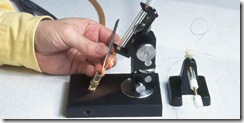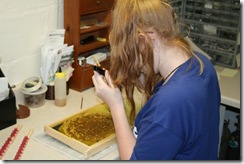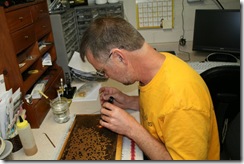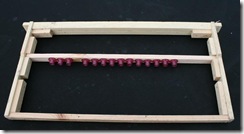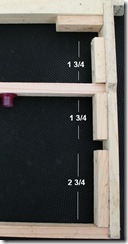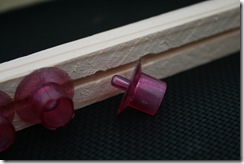 We love honey bees, also known as Apis Mellifera. Apis Mellifera is just the scientific name which means honey carrying bee, which technically is incorrect, as honey bees do not carry honey. They carry nectar and turn it into honey in the hive. So let's just call 'em honey bees!
We love honey bees, also known as Apis Mellifera. Apis Mellifera is just the scientific name which means honey carrying bee, which technically is incorrect, as honey bees do not carry honey. They carry nectar and turn it into honey in the hive. So let's just call 'em honey bees!
Honey bees swarm. They swarm for several reason, and for some reasons we'll never understand. Here I am watching a swarm from one of my hives land in my near by tree. You can click on the image for an enlarged view.
My wife and I clapped our hands, rattled a metal sheet around the swarm and believe it or not they went back into the hive they swarmed from. Either what we did worked, or for some unheard of reason, they just went back home. I know bees cannot hear, but they do "hear" by sensing vibrations.
 Beekeeping comes with many challenges. During May and June our biggest challenge is keeping our hives from swarming. I run my hives tight and full because I believe bees like to be crowded--not congested, but crowded. This year, I've only had 2 of my hives swarm. This one was high up so I put an empty hive on top of my truck and climbed up the ladder and shook the swarm down into the box on the truck. Imagine going through a fast food drive up with that on top of your truck! When a colony swarms, it loses a large number of it's population. Most agree that if a colony swarms, the remaining bees probably will not produce honey that year. So, no one wants to see a swarm unless it is someone elses. :)
Beekeeping comes with many challenges. During May and June our biggest challenge is keeping our hives from swarming. I run my hives tight and full because I believe bees like to be crowded--not congested, but crowded. This year, I've only had 2 of my hives swarm. This one was high up so I put an empty hive on top of my truck and climbed up the ladder and shook the swarm down into the box on the truck. Imagine going through a fast food drive up with that on top of your truck! When a colony swarms, it loses a large number of it's population. Most agree that if a colony swarms, the remaining bees probably will not produce honey that year. So, no one wants to see a swarm unless it is someone elses. :) Another beekeeping challenge is failing queens. Has your queen gone feet up on you? Maybe she's deformed, like this one which has lost an antenna. Or like this queen in the picture, maybe she needs wound up again. Sorry, when the queen runs out, there is no winding her back up. She will not mate again. Time for a new queen. This is another challenge we beekeepers face...failing or missing queens. None of us want to find a bunch of queen cells in our hives when the queen is doing great nor do we want to find that our queen is gone. We must have strong, young and great laying queens to keep our hives striving.
Another beekeeping challenge is failing queens. Has your queen gone feet up on you? Maybe she's deformed, like this one which has lost an antenna. Or like this queen in the picture, maybe she needs wound up again. Sorry, when the queen runs out, there is no winding her back up. She will not mate again. Time for a new queen. This is another challenge we beekeepers face...failing or missing queens. None of us want to find a bunch of queen cells in our hives when the queen is doing great nor do we want to find that our queen is gone. We must have strong, young and great laying queens to keep our hives striving.
Here's a queen cell in my hive. For those of you who have never seen a queen cell and have always wondered if you could identify one, here you go. Queen cells on the top half of the frame means they are replacing their old queen for some reason. And queen cells on the bottom of the frames mean they are preparing to swarm. Excessive swarming can be a trait within the queen's genetics. But it can also be environmental such as the hive is congested.
So, all of that being said, I want to wrap up my lessons on queen rearing for now with some final comments.
You are most likely going to keep buying your queens from reputable queen providers probably from the sunshine belt, where the weather is warmer longer so queens are easier to raise and can be raised earlier in the spring. And, we sell packages and queens from the south, so I don't want to shoot myself in the foot. But there are a few things we should consider about queens from the south.
First, they have to travel a long way to get to northern states. Shipping can be hard on bees and queens. It shouldn't be, but sometimes it is. Data recorders have shown that some queens were exposed to cold and hot temperatures that could effect the overall health of the queen. Delivery centers spray for insects. Could that spray residue effect queens as well? Not to mention that some states in the deep south are known to have Africanized bees. Great efforts are being made to keep the Africanized genetics out of the pool, but for open air mated queens, who can be sure, right?
I've heard farmers say you should buy your animals from the north and move then south but never buy them from the south and bring them north. Which brings us to the idea and consideration of whether a southern queen may not be able to survive a northern winter. That's hard to make a case around. Bees are bees, right. They are going to work and do what bees do. However, it makes sense to me to obtain a queen that is bred in the area of your own climate. For years people in the north have successfully over wintered hives purchased from the south. However, winter die outs are on the rise.
That being said, if you live in a northern state which has harsh winters, it just makes sense to purchase queens that have proven successful in northern climates. Here's why: First, you avoid shipping stresses. Secondly, you are obtaining a queen that has survived your unique climate. Thirdly, you know that your queen is from hives that have survived pests and diseases that are common in your area. To me, this makes sense. And with a near by queen breeder, you may be more apt to replace your queens regularly.
 Come on! Would you buy a queen from a hive that is known to have CCD or is Africanized? Of course not? Even though she may not carry or transfer the cause of CCD, no one would want to do that. Then, why would you buy a queen without knowing anything about her genetic track record? Usually because we get desperate to have a queen, and most queen breeders are desperately trying to sell queens and can no longer carefully monitor the genetics that governs the overall success of queens. This isn't the case with all southern or western queen breeders, yet the reality of the stress placed on queen production can sometimes cause shortcuts to be taken, in my opinion. I know for a fact that last year queens are sold as this year queens. Again, not everyone does this, but money does talk, and the bottom line governs business.
Come on! Would you buy a queen from a hive that is known to have CCD or is Africanized? Of course not? Even though she may not carry or transfer the cause of CCD, no one would want to do that. Then, why would you buy a queen without knowing anything about her genetic track record? Usually because we get desperate to have a queen, and most queen breeders are desperately trying to sell queens and can no longer carefully monitor the genetics that governs the overall success of queens. This isn't the case with all southern or western queen breeders, yet the reality of the stress placed on queen production can sometimes cause shortcuts to be taken, in my opinion. I know for a fact that last year queens are sold as this year queens. Again, not everyone does this, but money does talk, and the bottom line governs business.
Our long term goal is to raise queens from survivor hives, which are hives that have survived at least two northern winters, have gone untreated for all pests and disease for at least two years and have not been hindered by pests or diseases. And a hive that has other good qualities such as minimal swarming, gentleness and maximal honey production. That's a long term goal and will take years to improve this stock. For now though, we are achieving success along the way.
But remember, we can't always point the finger at our queens. There are some great coaches that just don't have the player skills to win games. Some queens may be great, but may face tough Springs. Is it fair to blame the queen for a tough spring? The older bees seem to be the ones that call a lot of the shots. Should we blame the queen when the older bees make poor decisions? Or, this is one none of us want to admit, but should we blame the queen for our poor management and poor manipulation of a hive? For example, some medications in the hive have been shown to reduce the queen's performance. Is it fair to blame the breeder or the queen because we poisoned her?
So be patient with the queen! We can all get a dude, but let's be sure before we give up on her.
So be patient with the queen! We can all get a dude, but let's be sure before we give up on her.
This is why you should consider raising your own queens. This year introducing my own young, freshly mated queens has made a huge difference in the overall performance of my hives. I realize it is impractical for every beekeeper to raise their own queens. That's why we need more and more local beekeepers to form regional queen rearing programs.
We have a limited number of queens we are selling this year. If you'd like to try one, please give us a call at 217-427-2678. We ship queens on Monday and Wednesday. By purchasing your queens from us, we are able to use that profit to expand our queen stock improvment program.
Also, if you are planning on becoming a beekeeper next spring, then please order your equipment and hives from us this summer or fall. It becomes very difficult for us to keep up with all the orders between February-June. Plan ahead!!
That's all for now, and remember...BEE-have yourself!
David & Sheri Burns
Long Lane Honey Bee Farms
217-427-2678
EMAIL: david@honeybeesonline.com











